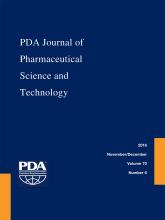Abstract
Technology transfer of biological products is a complex process that is important for product commercialization. To achieve a successful technology transfer, the risks that arise from changes throughout the project must be managed. Iterative risk analysis and mitigation tools can be used to both evaluate and reduce risk. The technology transfer stage gate model is used as an example tool to help manage risks derived from both designed process change and unplanned changes that arise due to unforeseen circumstances. The strategy of risk assessment for a change can be tailored to the type of change. In addition, a cross-functional team and centralized documentation helps maximize risk management efficiency to achieve a successful technology transfer.
- © PDA, Inc. 2016
PDA members receive access to all articles published in the current year and previous volume year. Institutional subscribers received access to all content. Log in below to receive access to this article if you are either of these.
If you are neither or you are a PDA member trying to access an article outside of your membership license, then you must purchase access to this article (below). If you do not have a username or password for JPST, you will be required to create an account prior to purchasing.
Full issue PDFs are for PDA members only.
Note to pda.org users
The PDA and PDA bookstore websites (www.pda.org and www.pda.org/bookstore) are separate websites from the PDA JPST website. When you first join PDA, your initial UserID and Password are sent to HighWirePress to create your PDA JPST account. Subsequent UserrID and Password changes required at the PDA websites will not pass on to PDA JPST and vice versa. If you forget your PDA JPST UserID and/or Password, you can request help to retrieve UserID and reset Password below.






